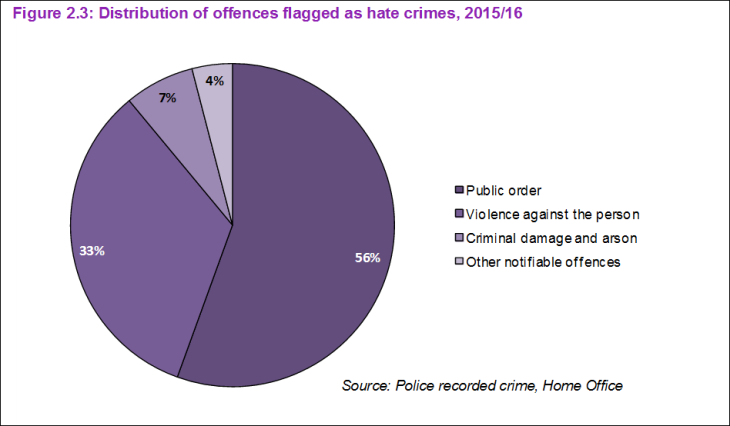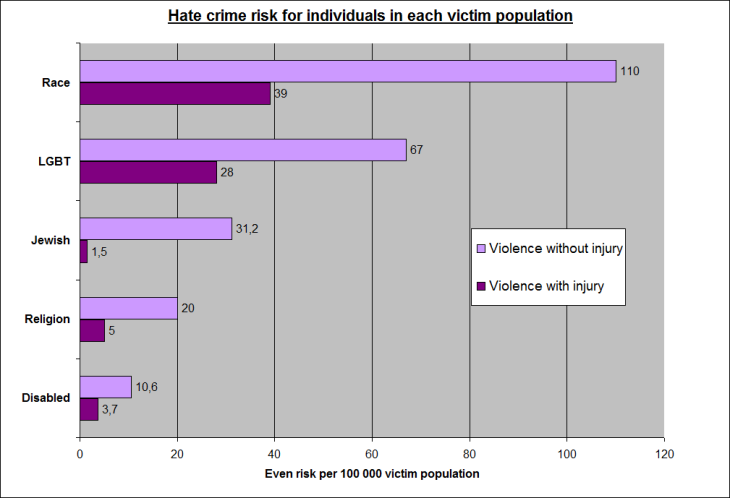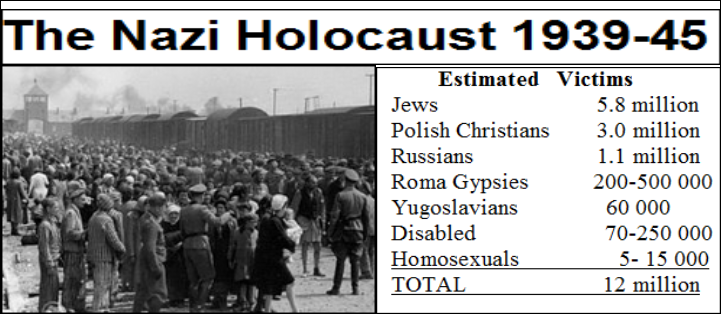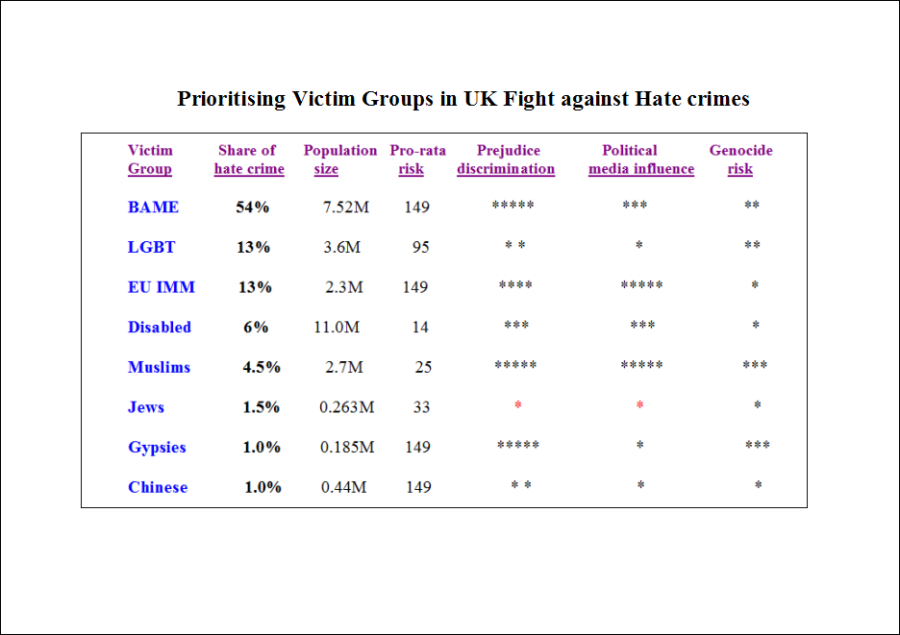Building an evidence-based strategy against abuse and hate crimes
By Dr Alan Maddison, 4th February 2017
Abstract
Hate crimes are categorised for motives of Racism, Sexual Orientation, Gender Identity, Religion, and Disability. Although the 62 518 hate crimes reported to the police over 12 months to 31st March 2016 represent only 1.8% of all victim-based crimes, they do generate considerable fear and anxiety due to the targeting of their victims. In addition, hate crimes are the tip of an iceberg composed of almost daily acts of prejudice and discrimination for many of the victim groups.
Unfortunately recent Government reports on tackling hate crime and anti-Semitism seem to be overly influenced by blatant political bias and political lobbying. Anti-Semitism accounted for only 1.5% of total reported hate crimes in 2015/16, yet attracts a disproportionately high level of political and media attention. This means that victims of the other 98.5% of hate crimes are not getting the share of attention they deserve.
In this article we have reviewed and analysed relevant evidence in order to better prioritise the resource allocation to different victim groups of hate crime. We have also researched evidence for specific sub-groups including victims from BAME, LGBT, EU Immigrant, Muslim and Jewish communities.
The data reviewed includes the share of hate crimes reported to the police for each victim group, their population sizes, pro rata risks for violent attacks, measures of prejudice and discrimination, political rhetoric, media coverage and risk for a future genocide.
Based on this evidence, greater prioritisation needs to be given to hate crimes motivated by Race (79% share of hate crimes), and in particular to the BAME (Black, Asian and Mixed Ethnicity) victim group which also suffers much discrimination in society.
The next priority is for EU immigrants and then the LGBT victims. They both have 13% share of hate crimes, but the EU Immigrants have suffered more by repeated political and media attacks around the brexit vote.
The Disabled victim group is just ahead of the Muslim group, with larger numbers of the Disabled population (11 million) just overcoming the greater prejudice, and more negative media and political comments directed at Muslims.
Jewish victims should occupy a low priority for any strategy to tackle hate crime based on all the factors examined, a 1.5% share of hate crimes, a small population (263 000), a low individual risk for assaults causing injury, and a supportive media and political class.
It seems the risk for a future genocide in the UK is low, but could involve any hate crime victim group today, or indeed a new group. To reduce the global risk, general high awareness for another possible genocide for all victim groups needs to be achieved as it is for Jewish groups today.
This evidenced-based prioritisation may provide the foundation of a more effective strategy to tackle hate crime. Related action plans should then be developed and implemented to best serve and protect all victims groups. Despite such prioritisation no individual and no community should in future be left behind.
Introduction
According to annual publications of the Crime Survey for England and Wales (CSEW) group, there are around 220 000 hate crimes each year of which only about one third are included in police reports.
Hate crimes are categorised for motives of Racism, Sexual Orientation, Gender Identity, Religion, and Disability.
Although the 62 518 hate crimes reported to the police in the 12 months to March 2016 only represent 1.8% of all victim-based crimes (3.45 million), they do generate fear and anxiety due to the targeting of their victims. In addition, hate crimes as the tip of an iceberg composed of almost daily acts of prejudice and discrimination for many of the victim groups.
In October 2016 two reports were published, one by the Government on ‘Hate Crimes’ and a second by a Home Affairs Select Committee (HASC) on ‘Anti-Semitism’. I have described, elsewhere how both these reports seem so distorted, by blatant political bias and aggressive political lobbying, that the effectiveness of any resulting action plans to help victims will be seriously compromised (‘Party Politics let down victims of hate crime and anti-Semitism’, November 2016, politicalsift.wordpress.com).
Despite being condemned by the UN, tabloid media and right-wing politicians inciting hatred against Immigrants, Muslims and the Disabled, are ignored in the first report. In the second report, instead of attacking the far right responsible for 70% of anti-Semitic attacks, the main focus was on alleged ‘rude comments’ within the Labour Party. As one critic said, anti-Semitism has been clearly weaponised to oust Jeremy Corbyn as Leader of the Labour Party, and to justify a relentless witch-hunt of his supporters who campaign for Palestinian human rights.
Such political manipulations not only undermine the genuine fight against hate crimes and anti-Semitism, but the victim groups these reports were designed to help are being let down.
For instance, anti-Semitism accounts for only 1.5% of total reported hate crimes, yet attracts a disproportionately high level of political and media attention. This means that victims of the other 98.5% of hate crimes are not getting the share of attention they deserve.
The MP’s involved in the compilation of these politically biased reports are leaving vulnerable the very victims that they were supposed to protect.
With a rise of the far right across the world, and the increased anti-foreigner atmosphere following the brexit vote in the UK, it is time to stop playing divisive political games and to build an evidence-based strategy to tackle all forms of racism, all categories of hate crime and anti-Semitism.
The purpose of this article is then to review available evidence on hate crimes and associated factors so that any future strategy to tackle hate crime has appropriate prioritisation and so serves the best interests of all hate crime victim groups.
1. The most frequently affected victim groups for hate crimes in society
There were 3.45 million victim-based crimes reported to the police in 2015 in England and Wales. Of these 62 518 (1.8%) were defined as ‘hate crimes.’ The breakdown of these hate crimes by motivating factor is given below in Table 1, for the period from 1st April 2015 to 31st March 2016.
Table 1.

Police do not always record victim details for racial or religious crimes and they are currently difficult to find at a National level. The breakdown data given in italics in Table 1 and also represented in Figure 1 below are estimates extrapolated from police reports from regions where such details were consistently reported or summarised (S. Isal and K. Schmitz, European Network against Racism). Incidents affecting Jews and Muslims were taken from the Jewish ‘Community Security Trust’ (CST) and the Muslim ‘Measuring Anti Muslim Attacks’ (Tell-MAMA) reporting organisations.
The overall increase in total hate crimes on the previous year was 19%, and for individual groups shown in brackets above. However, it is thought that much of this growth is the result of improved reporting.
According to CSEW (Crime Survey for England and Wales) the hate crimes are reported to the police only account for about one third of those committed. Whilst there is under-reporting for all groups, it is greatest for the Disabled victim group. In reality the 6% share for the Disabled group may be up to 5 times greater.
By far the most common motivation for these reported hate crimes above was Race (79%). The next most targeted group at (13%) was the LGBT (Lesbian Gay Bisexual Transgender) community.
Given the high political and media attention to anti-Semitism and Islamophobia, the 7%, reported hate crime share motivated by Religion seems rather low, even if attacks on Muslim women is thought to be under-reported.
The relative share of hate crimes is arguably the most significant evidence for prioritisation of victim groups as illustrated below in Figure 1.
Figure 1.
We can see the BAME victim group should be the top priority based on a hate crime share of 53%. Next priorities are LGBT (13%) and then EU immigrants (12%) of which the Polish make up just under half. The Disabled should be next if we take into consideration a very significant under-reporting. The victims of religious hate crime (total 7%) represent a lower priority, especially victims of anti-Semitism, which has only a 1.5% share of hate crimes.
2. Fear and anxiety for future attack in each victim group.
As stated earlier, hate crimes only represent 1.8% of victim-based crimes, but they do generate considerable fear and anxiety due to the targeting of their victims. About 11% of adults say they are ‘very worried’ about becoming the victim of a future hate crime, particularly a physical attack, due to their skin colour, ethnicity, or religion (CSEW).
For factoring this into a prioritisation process it may be useful to explore each victim group population size and the relative risk for an individual becoming a victim.
2.1 Population Sizes
The Disabled population is the largest at 11 million. Then the BAME group makes up about 7.5 million. For the LGBT community we have used the Government estimate of 3.6M.
The total victim group population sizes for ethnic minorities are illustrated in Figure 2 below, in order to provide a quantitative measure for the relative importance of such fear and anxiety.
Figure 2.
Muslims have a population of 2.7 million (many are also Asian), EU immigrants are next at 2.3 million, Chinese at 440 000, Jews at 263 000, and Gypsies at 185 000.
Not all ethnic minorities are included here.
2.2 Risk for a hate crime event for an individual within each victim group population.
So far we have looked at the collective data for hate crime victim groups. But is there a group in which individuals are at greater risk for becoming a victim of hate crime than others? If so this would probably lead to higher levels of fear and anxiety for any future attacks in that group. For instance does a Jewish person, albeit from a small population, suffer a higher pro rata risk than an Asian or Black individual coming from a larger population?
The distribution of hate crime offences is shown below in Figure 3.
Figure 3

Public order offences included those on social media as well as insulting behaviour in public places and elsewhere.
Violence against the person on average accounts for 33% of offences and is perhaps the most likely to generate fear and anxiety.
There are differences between victim groups with ‘Violence against the person’ shares ranging from 31% to 42%. We do not have reliable data for individual ethnic minorities except for the Jewish victims.
Using this data, the number of violent hate crimes (with or without injury) reported to the police for 100 000 of each victim population are illustrated below in Figure 4.
Figure 4.

The overall risk for any violent hate crime offence, as shown above, ranges from an incidence of 14/100 000 individuals for the Disabled population to 149/100 000 for those victims of a hate crime motivated by Race.
Just to provide some perspective, the risk for any UK adult being assaulted as a victim of a crime offence reported to the police but not motivated by hate is about 1600/100 000. So even a BAME victim is 10 times more likely to suffer an assault which is not motivated by race.
Despite this low risk level for hate crime assaults, we can see that the individual risk for violence is highest for the victim group defined by Race, then for LGBT victims. The individual risk for violence without injury is about average for a Jewish person, but who has the lowest risk for violence with injury.
3. The relative risk for genocide
So if the UK Jewish population of 263 000 is relatively small, and hate crimes against them and individual risk relatively low, why then does anti-Semitism seem to get a disproportionate level of attention and publicity? One reason may be the understandable fear of a resurgence of hate against Jews and a risk of history repeating itself with another horrific Nazi Holocaust.
As a result of a well-financed and resourced strategy, Jewish organisations have had a successful long-running awareness campaign regarding the appalling genocide of 6 million Jews in the Nazi Holocaust 1939-45.
However, there is much lower awareness of the other victim groups of the Nazi Holocaust as show below.

The 6 million non-Jewish victims are sometimes referred to as the “forgotten victims.” Any future plan should include increasing awareness of all victims as many of those listed above find themselves victims of hate crimes in the UK even today.
Many “forgotten victim” groups do not have the same level of resources or influence as those fighting anti-Semitism and this needs to be corrected to give them an equal voice.
Perhaps in the UK we could have evoked the shame associated with the Nazi Holocaust in order to protect other current UK victim groups, such as the Disabled, Homosexuals and Gypsies. In particular, to protect Polish victims of the post-brexit hate crimes we could have increased awareness that about 6 million Poles died in the Nazi Holocaust, an estimated 3 million Polish Jews and the same number of Polish Christians.
Greater awareness of non-Jewish victims of the Nazi Holocaust is all the more important when the raw statistics show for every 1 Jewish victim of a UK hate crime there were 4 Polish victims, 4 Disabled victims and 9 LGBT victims.
There have been many other genocides in history for which increased awareness might also reduce the risk for an appalling repetition and frequent violent hate crimes. The recent campaign “ Black Lives Matter” reminds us of the deaths around the Transatlantic Slave trade that the UN estimates at 17 million.

Before the Nazi holocaust the Jews were demonised as having infiltrated the media, politics, and finance in order to accumulate wealth and power. In the Transatlantic Slave Trade “holocaust” the Black victims were considered sub-human and so their lives did not matter.
It seems a long time ago, ending 200 years ago compared with 70 years for the Nazi Holocaust, yet whereas prejudice seems to have markedly declined against Jewish people (see section 3.1) the movement “ Black Lives Matter” indicates that things may still bad today for Black people who suffer 10 times more reported hate crimes in the UK than Jews.
It seems the risk for a future genocide is low for the UK, but as history show could happen elsewhere in the world. There is no evidence to justify allocating resources to just one particular victim group.
Attention should be given to the conditions which usually precede any genocide against a specific victim group, including;
- – a high degree of hatred in a given society
- – demonising by politicians and in the media
- – trigger events such as involving the economy or military conflicts
It may be helpful to explore these aspects in the UK in order to identify any victim group at greatest risk for genocide.
3.1 Relative prejudice against specific victim groups in the UK
There is little evidence for relative levels of prejudice for specific victim groups but the results from a European survey publishes by Pew Research (Spring, 2016) given below are interesting.
It should be said that not all people admitting negative views will then commit violence, but there should be a relationship between such prejudice and the risk for violence or even genocide in society as a whole.
Figure 5. 
In this recent survey only 7% of the UK population said they held any negative views about Jews, compared with 28% for Muslims and 45% for Roma/Gypsies. In fact the average for all European countries surveyed shows a similar pattern.
Based on these results we should be more concerned about possible violence, or even genocide, against Gypsies and Muslims rather than for Jews for whom who much progress has been made with long-running and high profile anti-Semitic campaigns.
In addition to comparisons of prejudice, there are also many measures of discrimination to examine for ethnic minorities.
In March 2015, UK unemployment rates were 5% for white people, 13% for Black people, and 9% for Asians. Jewish men and women were 15% and 29%, respectively, more likely to be in work than the average. Muslims were the most disadvantaged group in finding a job (76% less likely) and also in obtaining a managerial or better-paid job.
Inequalities in assets, income, poverty, and housing are more marked for the BAME and Muslim communities. BAME individuals are over-represented in all stages of the criminal justice process, disproportionately targeted by police, more likely to be imprisoned and given longer sentences than white people.
Discrimination has also been reported for LGBT (healthcare, social, career) and the Disabled (poverty, employment). In fact the Disabled have been hit nine times more by recent welfare cuts than any other recipient group.In conclusion, BAME, Muslim and Gypsy victim groups seem to suffer the greatest prejudice and discrimination and the Jewish community by far the least.
3.2 The UK media and certain politicians accused of inciting hatred
The UN has repeatedly criticised the UK for the inflammatory and abusive right-wing political rhetoric and tabloid media coverage regarding Muslims, EU immigrants and even our Disabled.
In April 2015 the UN High Commissioner for Human Rights, accused British tabloids of:
“ Decades of sustained and unrestrained anti-foreigner abuse, misinformation and distortion.”
In 2016, the UN Committee on the Elimination of Racial Discrimination said that prominent political figures created prejudice during the EU referendum campaign and failed to condemn racist abuse. The committee felt the 41% spike in hate crimes around the vote was a result of the “anti-immigrant” rhetoric of certain British politicians.
On 7 November 2016, the UN Human Rights Committee published its report into the state of disabled people’s human rights. Among other concerns, the committee said the UK government had helped to create a public perception where disabled people…
“…have been negatively portrayed as being dependent or making a living out of benefits; committing fraud as benefit claimants; being lazy and putting a burden on taxpayers, who are paying ‘money for nothing’. Persons with disabilities continue to experience increasing hostility, aggressive behaviour and sometimes attacks to their personal integrity.”
One journalist despaired that the Muslims were demonised in the same way the Jews were in the 1930’s. Indeed, anti-Semitic groups would never allow such a discourse against Jews as is currently aimed at Muslims, Immigrants and the Disabled, precisely because of the risks for another genocide.
On the 13th October 2016, the House of Commons Home Affairs Select Committee (HASC) published a report following their inquiry into anti-Semitism in the UK. There had been attempts to claim that anti-Semitism was rife in the Labour Party, but the HASC stated the following,

They also reported that 70% of anti-Semitic incidents were committed by elements of the far right.
According to the S. Chakrabarti report into anti-Semitism and all forms of racism (July 2016), there was no widespread anti-Semitism with Labour members, but occasional rudeness when discussing Palestine needed to brought under control.
The attempts to smear the Labour Party seem more to do with ousting Jeremy Corbyn as its Leader, and silencing any criticism of Israeli policies regarding the Palestinians. These tactics, which include a witch-hunt for supporters of Palestinian human rights in the Labour Party have been described already, by Jewish members of the Labour Party and even a late ex- Israeli Minister,

This manipulation discredits those involved. It damages the Labour movement, freedom of speech, legitimate support for Palestine, and the genuine fight against anti-Semitism.
To conclude, there has been a recognised inflammatory and abusive right-wing political rhetoric and tabloid media coverage regarding Muslims, EU immigrants and our Disabled. With respect to Jews, there are no anti-Semitism attacks by politicians or the media, in fact political rhetoric and media coverage is extremely supportive for Jews and never incites hatred.
3.3 Trigger events that may worsen prejudice
We have seen how, following the UK economic downturn, immigrants have been made the scapegoats by right-wing politicians for the hardships usually resulting from unnecessary political austerity selectively targeted to the poorest.
The wars in Iraq and Syria, the rise in terrorism, the large number of displaced immigrants, have all fed a climate of increased prejudice against Muslims and non-EU Immigrants in general.
The abuses of human rights for Palestinians by the Israeli Government has led to tensions, but these have declined in the UK since 2014, when the ‘disproportionate’ bombing of Gaza took place.
Otherwise, despite a resurgence of the far right globally, the UK is quite stable politically and certainly militarilySo in conclusion it seems the risk for a future genocide is low for the UK, but elsewhere in the world could involve any UK hate crime victim groups and could be a part of a prioritisation of resources and effort, both here in the UK and internationally. The evidence suggests the non-Jewish victim groups need to be given a greater share of voice to achieve as great an awareness of genocide/ Holocaust risks as that achieved for Jewish victim groups. Negative right-wing political and media campaigns waged against Muslims, Immigrants and the Disabled need to be halted for they have the potential for feeding the conditions for future genocides.
4. Prioritising victim groups in a strategy to tackle hate crime.
We have reviewed relevant evidence that can be used to provide an objective prioritisation for resource allocation to different victim groups of hate crimes, in order to determine an effective strategy to tackle hate crime.
Each element reviewed should carry a different weighting based upon its importance. One proposition, which also gives greater weighting quantitative data is as follows:
– the primary factor should be the share of hate crimes (section 1).
– secondary factors should include victim group population sizes (section 2.1) and individual risk (section 2.2 ).
– tertiary factors such as relative prejudice levels (section 3.1), media and political influence (section 3.2) and trigger events (section 3.3), they introduce more subjectivity.
The relevant information is summarised and tabulated below.
Table 2. Pro-rata risk of 149 is collective for Race ***** highly negative
Pro-rata risk of 149 is collective for Race ***** highly negative
* slightly negative * slightly positive
Based on this evidence the BAME victim group is given top priority, EU immigrants are next followed by the LGBT community.
The Disabled are just ahead of the Muslim with larger numbers of Disabled just overcoming the greater prejudice, and more negative media and political comments.
Chinese and Gypsies are lower in priority but we should be concerned for the high proportion of people with negative views about the latter.
Jewish victims should occupy a low priority for any strategy to tackle hate crime based on all the factors examined and illustrated in Table 2 above.
This article has been about prioritisation of the allocation of resource to tackle hate crime, but some support is needed for all hate crime victim groups, some not covered here (Sikhs, Hindus).
The broader context of discrimination as described in section 3.1 also needs to be taken into account. As an example the excessive BAME unemployment rate (9-13%) for instance, involves 400 000 victims.
Hate crimes (62 518) only represent 1.8% of all reported crimes (3.45M) so prioritisation of resources to tackle hate crimes needs also to be considered in the broader context. For instance, there were 106 000 victims of sexual abuse (of which 85% were women), and also 840 000 victims of child abuse.
However the prioritisation is finally determined, and some victim groups do merit a higher share of resources, no individual or community should be abandoned or forgotten.


Reblogged this on perfectlyfadeddelusions.
LikeLike